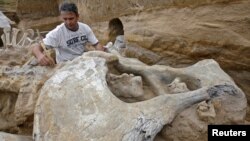Besides news items related to war crimes, territorial disputes, and the latest presidential gaffe, Serbia recently made headlines when a group of archeologists unearthed a site containing the skeletons of at least five woolly mammoths.
The discovery was made during coal excavations about 20 meters below ground, at a mine in Kostolac, a city located on the Danube river, east of Belgrade.
Miomir Korac, the director of Serbia’s Archeology Institute, said that the discovery of the mammoth field could shed light on what life was like in these areas during the Ice Age.
Korac described the discovery as “a global sensation and most likely the first mammoths' graveyard to be found anywhere in the world.”
Sanja Alaburic, an expert from Serbia’s Museum of Natural History believes the bones belong to the woolly mammoth, Mammuthus primigenius, which disappeared around 10,000 years ago.
It will take up to six months for the archeology team to unearth the bones, which could shed light on the effect of the Ice Age on the area now known as the Balkans.
However, there are others out there who are not satisfied with unearthing bones, but want to bring back the extinct woolly mammoth back to life.
In April, Russian scientists in cooperation with scientists from Japan and South Korea began work on an ambitious project aiming to resurrect the extinct woolly mammoth from biological material they extracted from Siberian permafrost.
The procedure entails implanting mammoth DNA into an elephant egg which would then grow inside the womb of an elephant.
-- Deana Kjuka
The discovery was made during coal excavations about 20 meters below ground, at a mine in Kostolac, a city located on the Danube river, east of Belgrade.
Miomir Korac, the director of Serbia’s Archeology Institute, said that the discovery of the mammoth field could shed light on what life was like in these areas during the Ice Age.
Korac described the discovery as “a global sensation and most likely the first mammoths' graveyard to be found anywhere in the world.”
Sanja Alaburic, an expert from Serbia’s Museum of Natural History believes the bones belong to the woolly mammoth, Mammuthus primigenius, which disappeared around 10,000 years ago.
It will take up to six months for the archeology team to unearth the bones, which could shed light on the effect of the Ice Age on the area now known as the Balkans.
However, there are others out there who are not satisfied with unearthing bones, but want to bring back the extinct woolly mammoth back to life.
In April, Russian scientists in cooperation with scientists from Japan and South Korea began work on an ambitious project aiming to resurrect the extinct woolly mammoth from biological material they extracted from Siberian permafrost.
The procedure entails implanting mammoth DNA into an elephant egg which would then grow inside the womb of an elephant.
-- Deana Kjuka





